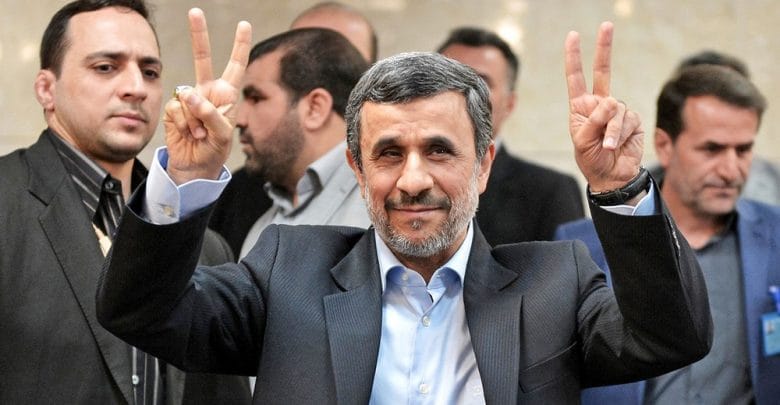
Does Mahmoud Ahmadinejad want to be president of Iran again?
As the election approaches, he is mulling a run. But the clerics might stand in his way
As members of the Iranian regime marched through the capital, Tehran, to mark Revolution Day on February 10th, Mahmoud Ahmadinejad held his own gathering. The former president, an irritant to clerics and liberals alike, had his fans gather outside his flat in a modest neighbourhood of Tehran, where they asked God to grant him a third term in office. The police eventually dispersed the crowd for gathering without a licence. With no hint of irony, Mr Ahmadinejad (pictured) then accused the relatively moderate current president, Hassan Rouhani, of “encroaching on the sanctity of liberty”.
Mr Ahmadinejad did plenty of that when he was in office. In 2009, after winning a second term in a fishy election, he crushed the largest protests in Iran since the revolution in 1979. His foes saw him as a populist troublemaker. Even his powerful allies grew tired of him. But as Iran gears up for an election in June, Mr Ahmadinejad is considering another run. Polls say he is the favourite—if the clerics let him stand. “He has immense popularity, especially among less educated and less affluent Iranians,” says Sadiq Zibakalam, a political scientist.
Mr Ahmadinejad got his start in politics at university during the revolution, when he co-founded a group uniting revolutionary student factions. Some people have accused him of being directly involved in the storming of the American embassy in Tehran and the taking of hostages. Mr Ahmadinejad denies this (apparently he thought the Soviet embassy was a more deserving target). He later joined the Basij, a militia run by the Islamic Revolutionary Guard Corps (irgc), the regime’s most powerful security force. But it was as mayor of Tehran that he distinguished himself as a conservative man of the people. Appointed in 2003, he reversed liberal reforms put in place by his predecessors and won over the public by, for example, helping street-sweepers clear the rubbish.
Iran held a presidential election in 2005. Then, as now, the public was angry with corrupt insiders rigging the economy. Many saw Mr Ahmadinejad as someone who would take on the elite and clean things up. His scruffy checked shirts and use of slang in campaign speeches were a contrast to the clerics. Yet he was also supported by conservative voters and, most importantly, by the supreme leader, Ayatollah Ali Khamenei.
Mr Ahmadinejad became the first and only layman to win the presidency since 1981. During two controversial terms (from 2005 to 2013) he denounced America, Israel and the Arab states, souring relations. At home he increased spending and maintained subsidies, winning over the poor but racking up huge deficits in spite of record oil revenues. He also struggled with the clerics over personnel matters, among other things. They supported his re-election in 2009 and the quashing of protests, but the animosity between them grew.
When Mr Ahmadinejad asked Mr Khamenei for permission to run again in 2017, the ayatollah told him that it was not in Iran’s best interests. His candidacy was eventually rejected by the Guardian Council, which oversees electoral matters and is controlled by Mr Khamenei. Protests over the economy broke out later that year. Mr Ahmadinejad’s response was initially circumspect (angering some), but he would later criticise all of Iran’s leaders. More recently he wrote to Vladimir Putin, Russia’s president, telling him not to stay in office forever. That was seen as a veiled message to Mr Khamenei, who now keeps Mr Ahmadinejad at a distance. The authorities have shut down Mr Ahmadinejad’s website and arrested some of his advisers.
While Mr Ahmadinejad’s relationship with the clerics has grown worse, his hostility to America seems to be dimming. During his time in office, America rallied international support for economic sanctions aimed at stopping Iran’s nuclear programme. Mr Ahmadinejad’s threatening rhetoric made that easier (he once said Israel should be “wiped from the map”). But in 2019 he called on the Iranian government to talk to Donald Trump, then America’s president, who had ditched a deal under which Iran curbed its nuclear programme in return for sanctions relief. Perhaps Mr Ahmadinejad saw something of himself in Mr Trump, another populist demagogue who uses language like a club.
Mr Ahmadinejad posts on Twitter (unlike Mr Trump, who was banned). He writes notes to Angelina Jolie, an American movie star, and quotes Tupac Shakur, a deceased American rapper. In January he spoke to Fox News, a cable network in America that often has guests who are hawkish on Iran. “I have sent a letter to [President Joe] Biden after he was elected,” said Mr Ahmadinejad. The text of the letter is vague, but the move suggests he would be open to dialogue with America’s new president, too. “He knows many Iranians have had enough with anti-Americanism and want a deal with America,” says Mr Zibakalam. “He’s bold enough to do it and, unlike Rouhani, he does not fear the supreme leader’s wrath.”
Will the supreme leader allow him to run, though? The clerics might see his candidacy as a way to get out the vote at a time of widespread disillusion with the status quo. But they clearly do not trust him. Mr Ahmadinejad, for his part, remains coy about his future. Regardless of whether he runs, many think he will continue to influence politics. Critics call him bache-porrou, a rude child who cannot be tamed. “He’s trying to remain relevant till the time of crisis,” says Saeid Golkar, an Iran-watcher in America. “If the supreme leader dies or the regime collapses, he wants to be there to fill the vacuum.”
